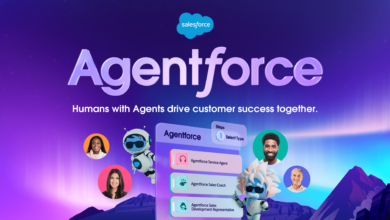What Are Content Managers, and How Do You Become One?

As a writer exploring the world of content management, I found myself asking the same questions you might be grappling with right now: What does a content manager really do? How is it different from being a content writer? And most importantly, could this be my next career move?

After weeks of digging into the role — examining job descriptions, industry insights, and speaking with professionals — I’ve come to see content management in a whole new light.
It’s far more strategic than I expected, blending the creative skills we writers already have with business acumen, project management, and leadership.
In this guide, I will explain everything I have learned about the content manager role, including its daily responsibilities, the key skills to develop, and its place in the broader content landscape.
Whether you’re a writer like me who is considering this transition or someone brand-new to the field, consider this a roadmap to discovering what it truly takes to succeed as a content manager.
Table of Contents
What is a content manager?
A content manager oversees the development, distribution, and strategic efforts of creating messaging to inform and delight audiences. This role usually involves knowledge of digital marketing software, tools, and methods with a focus on content and SEO. The role also requires people and project management skills.
When I started learning about content management as a role, I assumed it was just an elevated version of a writer’s job. But the deeper I dug, the more I realized how much strategy and coordination this role actually involves.
Content managers are the architects of a brand’s content strategy. They don’t just write — they figure out what to say, how to say it, and when to say it, all while staying true to the brand’s voice.

Their goal? To create content that doesn’t just exist but connects with an audience and drives action.
But that’s just one part of the job. Being a content manager also means wearing multiple hats: leading projects, coordinating with teams across marketing, design, and even product, and making sure every piece of content fits into the bigger picture. It’s like being a conductor of a very creative orchestra.
This isn’t a role you usually step into right out of the gate. Most content managers bring a few years of experience in marketing, communications, or project management to the table.
They’re expected to guide their team, make strategic decisions, and help others grow—all while juggling deadlines and delivering results.
If you’re thinking about becoming a content manager (like me), start looking at ways to stretch your skills. Lead a project. Learn about SEO and analytics. Start thinking about content beyond the words — what’s its purpose, and how does it align with a brand’s goals?
That’s just a glimpse into the role. Up next, we’ll dive into the daily tasks and responsibilities that bring this job to life.
What does a content manager do?
Content managers have varied roles depending on the industry or company they work for, but generally, they develop content topics and campaigns for their company, which are then distributed over the company’s website and social media profiles. They also have a hand on editorial work and are responsible for driving engagement and traffic through their projects.
One thing I quickly learned is that the role of a content manager can look very different depending on the company structure.
At a startup, a content manager might be the entire marketing department, juggling everything from strategy to execution. In a larger enterprise, they might specialize, managing content for a single team or project.
No matter the setting, content managers take on a variety of responsibilities. They might own the editorial calendar, plan out content topics, analyze data reports, manage social media accounts, or even write long-form editorial pieces.
It’s a role that balances creative output with strategic oversight.
As Alicia Collins, global brand marketing leader at HubSpot, explains, “Content managers wear many hats. Their job consists of so many moving parts — managing blogs, managing social, managing offers … in some cases, they can be a one-person marketing team.”
Even with all these variations, there are some common threads that tie the role together. Let’s dive into those shared responsibilities and what they really mean for day-to-day work.
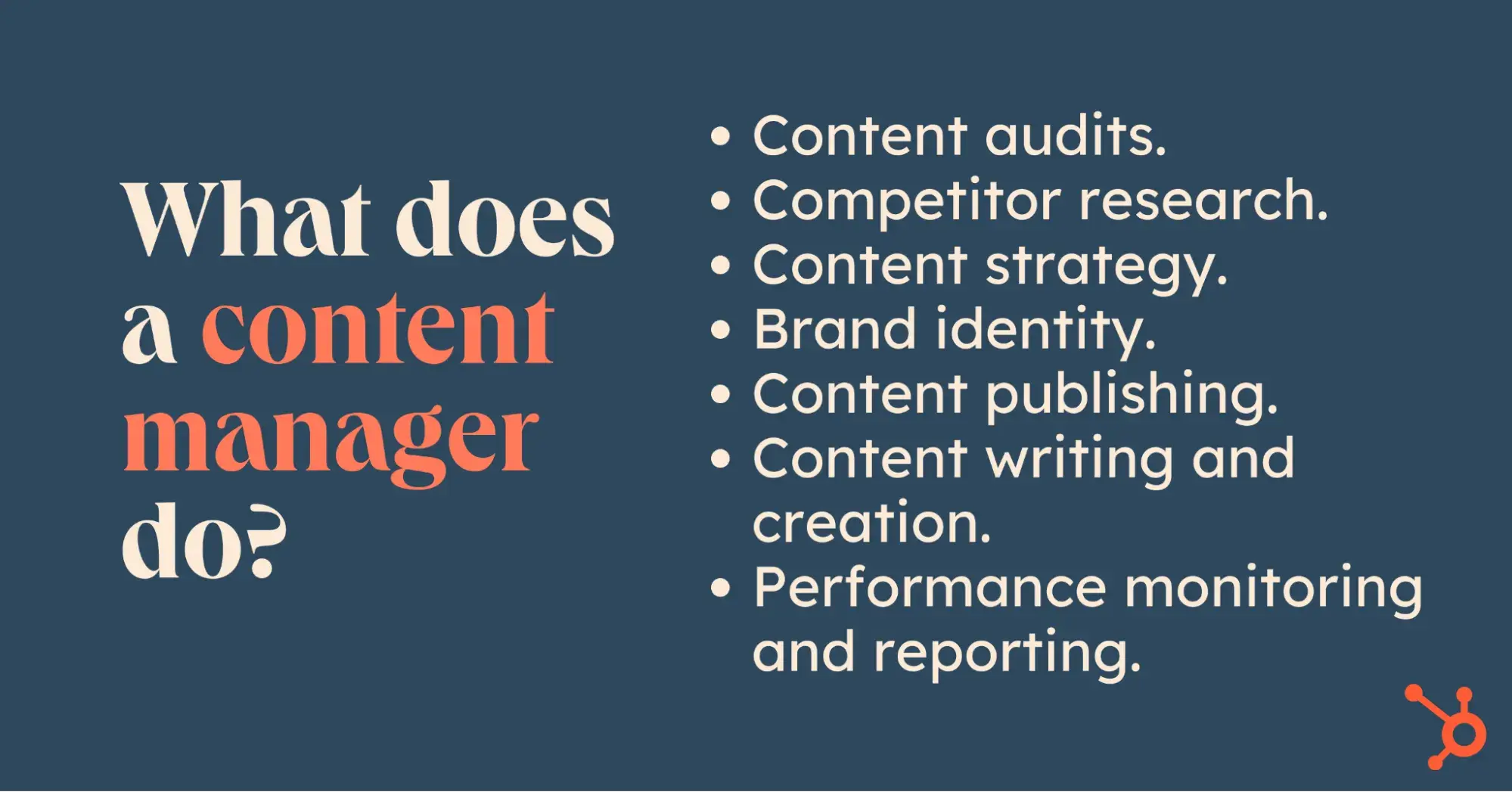
Content Manager Responsibilities
The responsibilities of a content manager include:
Auditing the existing content on the company’s website for brand voice, relevance, and optimization.
Researching competitors to find content gaps and keyword gaps that your company hasn’t yet covered.
Creating a new content strategy that can help your company reach its traffic goals
Promoting a consistent brand identity through the company’s social media profiles.
Creating a long-term and short-term content publishing calendar and social media calendar.
Writing the new content or managing a team of freelancers and writers to create the new content.
Monitor the content’s performance through online tools such as Google Analytics, Ahrefs, and Google Search Console.
What sorts of skills do you need to carry out these responsibilities? I’ll dive into more detail next.
Content Manager Skills
SEO Copywriting and Blogging
Data Analysis
Basic Coding
Content Management System Proficiency
Marketing Tools
Strategic Planning
Time Management and Organization
Leadership
By now, you probably have a clear idea of what a content manager does. But understanding the role is just the first step. The next question is: What skills do you need to not just do the job, but thrive in it?
Content managers are more than creators — they’re storytellers with a strategic lens. Every piece of content they produce or oversee reflects the company’s brand and speaks directly to its audience.
It’s not just about writing a great blog post; it’s about telling stories that build trust, engage readers, and drive results.
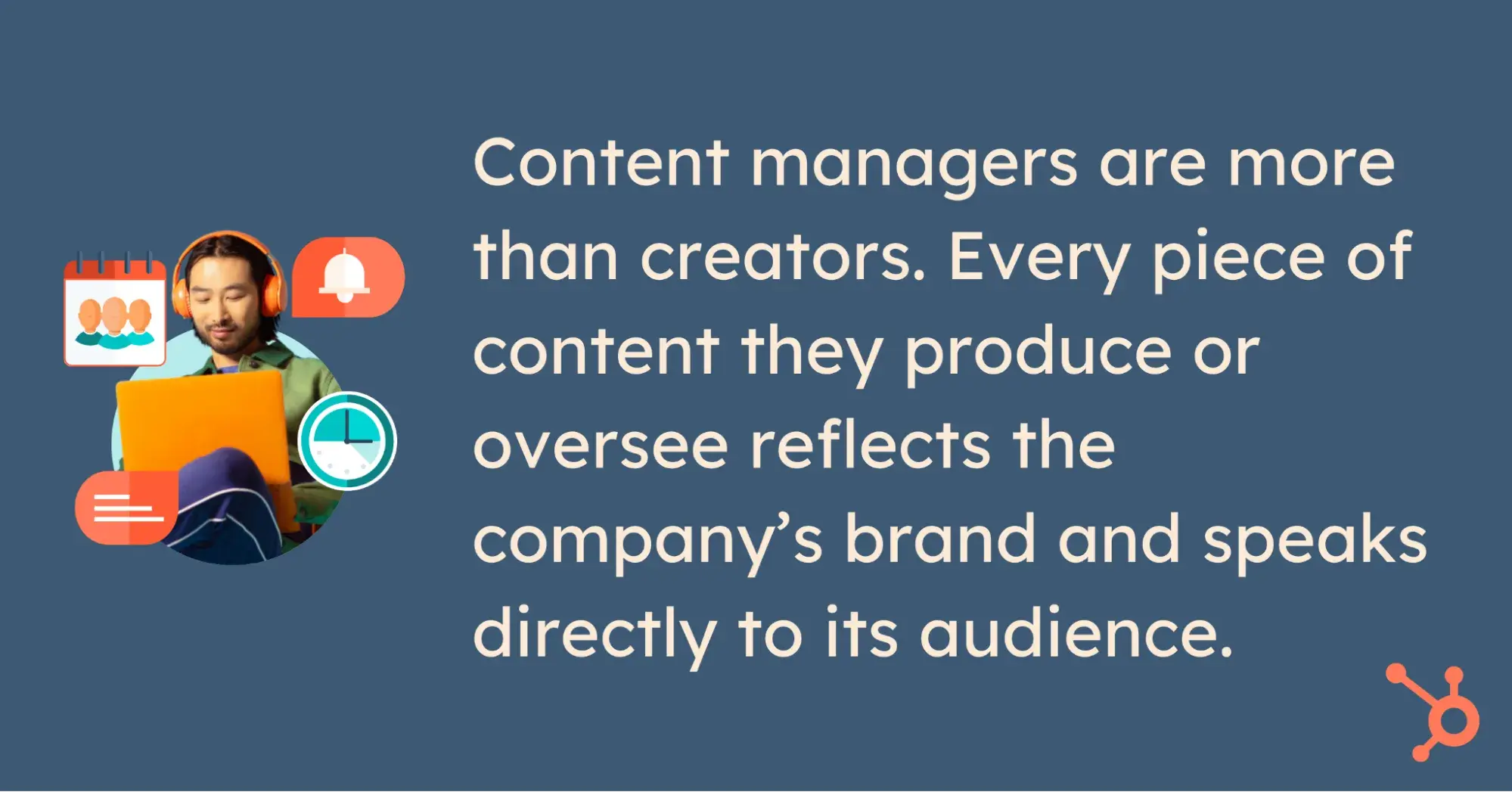
We’ve already discussed a few key skills: creativity, strong writing abilities, data interpretation, and organizational prowess. But thriving as a content manager requires more than just the basics.
To truly stand out, you’ll also need a working knowledge of some other crucial areas — and that’s exactly what we’ll explore next.
1. SEO Copywriting and Blogging
When I first started exploring content management, I assumed my writing skills would be enough. But I quickly learned that while writing is foundational, content managers need a broader understanding of SEO and brand storytelling.
Think of it this way: As a content writer, you craft the story. As a content manager, you‘re in charge of an entire narrative strategy that reaches the right audiences through search. You’re not just writing in a brand voice — you’re defining and evolving it and then teaching others how to use it effectively.
Senior Podcast Producer Matt Brown puts it perfectly: “Empathizing with your audience and telling a story worth listening to is always the greatest skill a content manager should have.”
Beyond crafting content, you’ll guide others in creating it, too. This means developing strong editing skills and knowing how to maintain quality at scale.
Tools like Hemingway Editor and Grammarly can help, but your strategic oversight is what truly elevates content from good to exceptional.
2. Data Analysis
One of the biggest surprises in my content management research? Just how much numbers matter.
As someone who’s always lived in the world of words, diving into data analysis felt like learning a new language. But here‘s what I’m discovering: content managers need to be bilingual in both creativity and metrics.
Every piece of content tells two stories — the one written in words, and the one written in numbers.
Page views show you who‘s visiting, click-through rates reveal what catches their eye, SERP positions tell you if you’re being found, and conversion rates? They’re the ultimate measure of whether your content is actually moving people to action.
I‘ll be honest: tracking metrics isn’t part of my daily routine as a writer. But I’m starting to see how these numbers unlock deeper insights about audience behavior.
They’re the difference between creating content you think will work and knowing what actually resonates with your readers.
The learning curve feels steep sometimes — trust me, I’m still getting comfortable with analytics dashboards! But understanding these metrics seems essential for making the leap from content creator to content strategist.
After all, how can you lead a content strategy if you can’t measure its success?
3. Basic Coding
As I‘ve been looking at different content management roles, I discovered that basic technical skills come in handy — but don’t panic! Most content managers aren’t expected to be developers.
However, knowing some HTML and CSS basics has emerged as a valuable skill for those times when you need to make quick content tweaks yourself.
Think of it like being able to change a tire without being a mechanic. Sometimes, you’ll need to dive into your content management system and adjust a heading style or fix a broken link without waiting for the dev team.
From what I’ve learned, these small technical tasks pop up more often than you might expect in content management.
I‘m still building my own coding knowledge, but it’s reassuring to know that mastering the basics is enough to handle most day-to-day content management needs.
4. Content Management System Proficiency
Content management systems are central to the role. They’re your digital command center.
While Content Hub offers a beginner-friendly trial with drag-and-drop features, WordPress seems to be an industry standard that most employers expect you to know.
I appreciate that these platforms let you test the waters before diving in. Content Hub’s 14-day trial feels like CMS training wheels, giving you space to experiment without breaking anything. From what I understand, once you’re comfortable there, tackling complex features on WordPress becomes less daunting.
Like many aspects of content management I‘m discovering, it’s about starting with the basics and gradually building your confidence.
5. Marketing Tools
You’ll also want to know your way around a few other tools. Generally, knowledge of one or two marketing tools for every facet of content production and management will cover your bases.
This includes programs to enhance content as well, such as automatic grammar check software or graphic design tools.
Mastering Google Analytics and Search Console is a must for properly tracking your marketing analytics. On the creative side, tools like Canva will help you quickly create a variety of visuals, from social media posts to infographics.
It‘s also a good idea to know how social media is used as a business tool and when that applies to your company’s marketing campaigns. Knowing how to use a tool like HubSpot would help with social media management.
6. Strategic Planning
As a content manager, you’ll spend ample time strategizing how to deliver targeted messages to your audience. That means you won’t throw out messaging willy-nilly, but very carefully and strategically craft the messaging’s wording and timing.
Justin Champion, Principal Product Manager at HubSpot, says, “An effective content manager needs to have a vision of what story they’re trying to tell. This will help them create a cross-platform content strategy that will give the best experience possible to their audience.”
7. Time Management and Organization
As a content manager, you’ll be handling various content calendars and juggling a wide variety of responsibilities. Organization and time management skills are among the top qualities of the best content managers.
Luckily, you don’t have to be innately organized or a strict timekeeper. You can use project management apps to keep everything going along smoothly.
Remember, as a content manager, you’ll likely be the leader of a team and the go-to person for status reports. As such, you’ll want to be as organized as possible. That way, you’ll have access to the information you need when you need it.
8. Leadership
A good content manager has some leadership skills, but this doesn’t necessarily mean that you need to be an extrovert who speaks at the front of the room.
You can be a leader by keeping the content management projects progressing smoothly, sending reports before higher-ups ask for them, and launching new campaigns to keep your company top-of-mind for leads and customers.
In some cases, you may need to manage a team of content coordinators or writers. That’s where more traditional leadership skills come in, such as being a great people manager and adopting a leadership style that helps your team grow.
Pay close attention to the wording in any job listing for a content manager. You could be the only person on your team or the leader of your team.
Now that we‘ve covered the essential skills for content management, you might be wondering where exactly these skills can take you. The content manager role isn’t one-size-fits-all — in fact, there are several distinct paths you can pursue.
Types of Content Managers
Social and Community Content Managers
Social and community content managers serve as the voice and personality of brands across various social platforms.
They are responsible for building and nurturing online communities while maintaining consistent brand messaging across social media channels.
I experienced this firsthand while managing Kyvio’s 7,000-member Facebook community, where engaging with course creators and highlighting success stories was central to our strategy.
Key responsibilities:
Community building and engagement.
Create content and adapt it to different platforms.
Social listening and crisis management.
Analytics and optimization.
Collaboration and campaign coordination.
Website Content Managers
Website content managers are the architects of a company’s digital presence, responsible for crafting and maintaining a seamless user experience while meeting business objectives.
They oversee everything from homepage messaging to site navigation, ensuring that content is accurate, timely, and effective.
Working extensively in content management systems, they collaborate with multiple departments to align messaging with brand goals.
A significant part of their role involves SEO optimization, enhancing content discoverability and search rankings. Additionally, they use website analytics to understand user behavior and make data-driven decisions about content placement and structure.
Key responsibilities:
Managing and updating website content to align with business goals.
Ensuring a balance between user experience and functionality.
Collaborating with cross-functional teams to maintain consistency.
Implementing SEO best practices to boost content visibility.
Leveraging website analytics to optimize structure and performance.
Editorial Content Managers
Editorial content managers operate much like traditional publishers, overseeing the entire content pipeline from ideation to publication. They are the gatekeepers of content quality and voice.
During one project, I worked under an editorial content manager who was meticulous about maintaining a consistent voice across all publications. They often emphasized that no matter how innovative the ideas, they wouldn’t resonate if the execution didn’t align with the brand’s tone.
Their rigorous fact-checking process taught me the importance of quality control in building trust with readers.
What stood out about their approach was their focus on the pipeline itself — ensuring every piece moved seamlessly from ideation to publication. It wasn’t just about individual pieces of content but how they all worked together to form a cohesive story.
Key responsibilities:
Managing editorial calendars and coordinating with writers and editors.
Maintaining content quality through adherence to style guides and fact-checking.
Ensuring a consistent tone and voice across all publications.
Analyzing content performance and making data-driven improvements.
Marketing Content Managers
Marketing content managers take a broader view, developing strategies that span multiple channels and content types. They oversee the creation of everything from blog posts to white papers, ensuring alignment with overall marketing objectives.
In contrast, the marketing content manager I worked with focused more on the big picture, tying every piece of content to overarching business goals.
For example, while the editorial content manager ensured the blog posts were polished and engaging, the marketing content manager asked how those posts supported lead generation or brand awareness.
One key distinction I noticed was how the marketing content manager handled stakeholder relationships. They were often in meetings with sales and leadership teams, aligning content strategies with broader company objectives.
This made their role more cross-functional compared to the editorial content manager, who focused on the content itself.
Key responsibilities:
Developing a comprehensive content strategy that aligns with business goals.
Collaborating with SMEs, designers, and writers for high-quality output.
Tracking performance metrics and iterating based on data insights.
Overseeing budgets and ensuring ROI on content investments.
Technical Documentation Managers
Technical documentation managers blend technical expertise with communication skills to transform complex information into accessible, user-friendly content.
Their primary focus is on ensuring that users — whether internal teams or external customers — can easily understand and apply the information they provide.
These managers oversee documentation for products, services, and internal processes, often working closely with development teams to grasp technical details.
They establish standards, maintain version control, and uphold accuracy across all materials. In addition to writing, they create templates and style guides to streamline documentation processes and implement tools to improve efficiency.
Key responsibilities:
Manage comprehensive documentation, including user guides and API references.
Establishing documentation standards, style guides, and templates.
Collaborating with development teams to ensure accuracy.
Implementing and managing documentation tools like Confluence or MadCap Flare.
Tailoring content for internal teams and external users.
Ecommerce Content Managers
Ecommerce content managers focus on creating and managing content that drives conversions and enhances the customer shopping experience.
They handle everything from product descriptions to multimedia content, ensuring that every piece of content is optimized to inform, persuade, and ultimately convert visitors into buyers.
Their work is at the intersection of storytelling, data management, and technical execution. A strong ecommerce content manager combines creativity with analytical skills to craft compelling content while maintaining accuracy and consistency across large catalogs.
Key responsibilities:
Managing large product catalogs and ensuring data accuracy.
Crafting compelling product descriptions that balance persuasion and information.
Collaborating with merchandisers to understand product features and benefits.
Using tools like Shopify or Magento to update and manage product pages.
As companies grow and marketing evolves, content management roles are becoming increasingly specialized.
Whether it’s crafting strategies as a marketing content manager, creating engaging experiences as a social and community content manager, or optimizing websites for user experience, these roles are essential to the success of modern marketing teams.
But here’s the thing: it’s not just about landing the title.
To truly excel, you’ll need to embrace a mindset that prioritizes agility, strategic thinking, and data-driven decision-making. Let’s break down what that means in the next section.
What It Really Takes to Succeed as a Content Manager
Becoming a content manager is an exciting career path, but the role involves more than creating and managing content. Here are some great insights from Chris Toy, CEO of MarketerHire, on the skills and attributes you’ll need.
1. Agility: Pivoting quickly in a fast-changing landscape.
“Marketing changes faster than anything,” says Toy. “Your team has to be built for that agility — ready to adapt to new trends, tools, or even a shift in strategy overnight.”
As a content manager, you’ll often face situations where priorities shift unexpectedly. For instance, a sudden platform algorithm change could render your current strategy less effective, or a viral trend might demand immediate action.
Agility means being prepared to adjust your content plans without losing focus on your broader goals.
What this means for you:
Stay informed about industry trends and platform updates.
Be comfortable with experimenting and iterating on content strategies.
Develop systems that allow you to pivot quickly without chaos, such as maintaining a backlog of adaptable content ideas.
2. Strategic thinking: Balancing the big picture with execution.
“There’s been a trend toward execution over strategy in marketing,” explains Toy. “Because it’s so easy to publish content, many companies skip strategic thinking altogether. That’s a big mistake.”
A strong content manager understands the importance of strategy as the foundation of effective execution. While creating and publishing content is essential, it’s equally critical to know why you’re doing it, who you’re targeting, and how it fits into the company’s broader goals.
What this means for you:
Always ask how your content contributes to your company’s marketing objectives.
Balance day-to-day content creation with time for brainstorming and long-term planning.
Don’t just execute — evaluate the results and refine your approach.
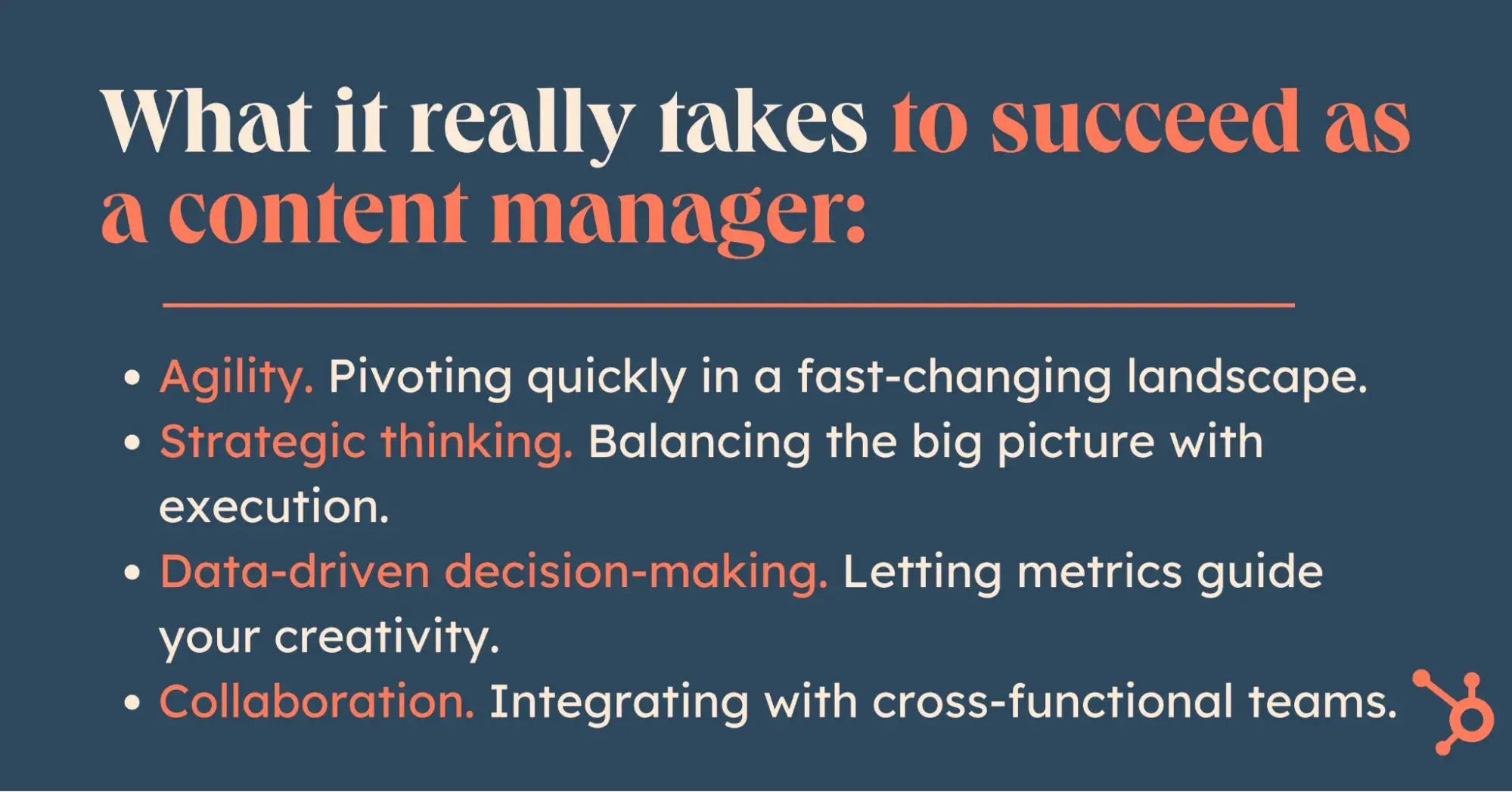
3. Data-driven decision-making: Letting metrics guide your creativity.
“Without data, you’re just guessing,” says Toy. “Whether it’s a website manager optimizing navigation or an ecommerce manager tweaking product pages, data is what turns creative ideas into effective strategies.”
Every piece of content you manage should be informed by metrics. From social media engagement rates to website conversion data, understanding and acting on the numbers can transform your content from good to great.
What this means for you:
Familiarize yourself with analytics tools like Google Analytics, Hootsuite, or SEMrush.
Use data to identify what resonates with your audience and double down on those strategies.
Don’t fear failure — treat underperforming content as an opportunity to learn and improve.
4. Collaboration: Integrating with cross-functional teams.
“Do you have the right people who can even be credible and come to the right conclusions?” Toy asks. This insight applies not just to hiring but to collaboration. As a content manager, you’ll frequently work with designers, strategists, and data analysts, ensuring everyone is aligned.
What this means for you:
Communicate clearly and consistently with other team members.
Be open to feedback and willing to adjust your content to fit the team’s collective vision.
Advocate for content’s role in achieving overall business goals during cross-departmental discussions.
Chris Toy sums it up: “The modern marketing team isn’t static — it’s agile, strategic, and laser-focused on results.”
As a content manager, your role will demand a unique blend of creativity, adaptability, and analytical thinking. It’s about more than just creating content — it’s about constantly evolving with the needs of the business and the expectations of your audience.
If you’re ready to step into this role, focus on building the skills that matter most: agility, strategic thinking, data fluency, and collaborative communication. With the right mindset, you’ll be ready to succeed in a world where the pace of change keeps everyone on their toes.
How to Become a Content Manager
The path to content management isn’t always direct, but these foundational steps can help you build the skills and experience needed for this strategic role.
1. Take a content marketing certification course.
No matter your background or years of experience, if you’re shifting from another career into content management, you’ll want to re-learn the ropes of content marketing to ensure you’re up-to-date.
If you’re coming from a completely unrelated field, consider taking courses on digital marketing to introduce you to the basics.
Take a course to help you strengthen your content marketing skills. I recommend starting with our certification course.
Upon completion, you’ll get a certificate that verifies your comprehension of content marketing (plus, you can add it to your LinkedIn profile).
2. Consider higher education.
While a degree will not always be necessary to land a content management role, it can certainly be a useful foundation. A degree in marketing, communications, journalism, or a related field is common among content managers.
Why?
They provide the basics of media best practices and ensure practitioners have a good grasp of storytelling and written communication.
3. Get familiar with SEO.
At countless firms, content marketing is synonymous with search engine optimization or SEO, so you’ll want to have a firm grasp of the concept as you seek a content manager role.
If you don’t know the rules of SEO, you might write content that’s not appropriately targeted or that serves no purpose other than filling up your company’s blog.
You’ll need to know how to carry out keyword research and use the appropriate software to find “green space” for your company’s website. Green space refers to keywords with low competition and high potential for serving your audience’s needs.
4. Create a personal website.
There’s no better way to start content management than by building a personal website with content that you uploaded and wrote yourself. This website could be for your own personal brand, for a company idea you’ve had for a while, or simply for fun.
Whatever it is that you create, you want to get familiar with creating a website from start to finish so that when it’s time to manage your future employer’s site, you can do it easily.
You’ll learn a few things through this process, including how to upload content and media, how to manage that content once it’s been uploaded, and how to effectively structure your site. It’ll also teach you how to get around a content management system.
Use your learnings from this process to give thoughtful answers to your interviewers when you’re applying for content management roles.
5. Consider freelancing to gain experience.
In addition to creating a website to boost your personal brand, freelancing is an excellent way to gain experience and build your portfolio. Potential employers want to see proof that you can deliver on their campaigns.
So, taking on projects as a freelancer and displaying successful ones on your personal website will help you gain practice and credibility.
Sites like Media Bistro and Fiverr can help you find contract or freelance work to help fill your resume. The more work you can pick up, the better as each project will help you hone your marketing skills and gain confidence.
6. Apply for an entry-level marketing role.
It’s time to search for a role. Unfortunately, content management is a mid-level role, meaning that most content managers have been in the marketing industry for a few years.
If you’re just getting started with marketing, you’ll want to start with an entry-level role and then move up into content management.
Your best bet is to apply for a marketing coordinator role. Marketing coordinators typically oversee the day-to-day responsibilities of running marketing campaigns.
This entry-level role will help you learn how to run a successful campaign, in addition to getting familiar with all of the stakeholders that need to be involved.
Another entry-level option would be a social media coordinator role. Social media coordinators are responsible for curating content for a brand’s social media platforms.
This role will still be within the marketing department and give you the opportunity and liaise with other marketing experts on the team.
Not all marketing roles are created equal. Look for the following words in the job posting to ensure you’re starting on the right foot:
If the job posting seems too general or if it seems to concern more traditional marketing methods, such as live event marketing or advertising, you’ll want to avoid it. Content managers work almost exclusively on the digital side of marketing.
7. Take on content management tasks within your role.
In your entry-level role, you’ll want to take on the duties of a content manager without yet being a content manager by name. For instance, if your team is missing a content calendar, could you volunteer to create one (without stepping on anyone’s toes)?
What about volunteering to upload the week’s new content onto the CMS?
It’s important to continue expanding your technical and practical content management skills as you prepare to apply for an actual content manager role.
8. Apply for a content manager role.
Once you have enough experience under your belt, it’s time to move into content management —either by becoming the manager of a content team or taking on more strategic roles within a marketing team.
Remember to use every piece of experience you’ve gathered thus far to show how well you can communicate with an audience and how well you’ve distributed content in the past.
Lead with the results of your actions and measure them in numbers. Content reach, organic traffic, and other engagement metrics are just a few data points you can use to show how effective you can be as a content manager.
Now that you understand the path to becoming a content manager, let‘s examine real-world job descriptions to see how different companies structure this role and what they’re looking for in candidates.
Content Manager Job Description Examples
Let’s examine real-world content manager job descriptions and break down what makes each unique.
Content Marketing Manager: NewBreed
When I read through the description of the Content Marketing Manager role at New Breed, one thing was clear: this isn’t just about creating content — it’s about driving results.
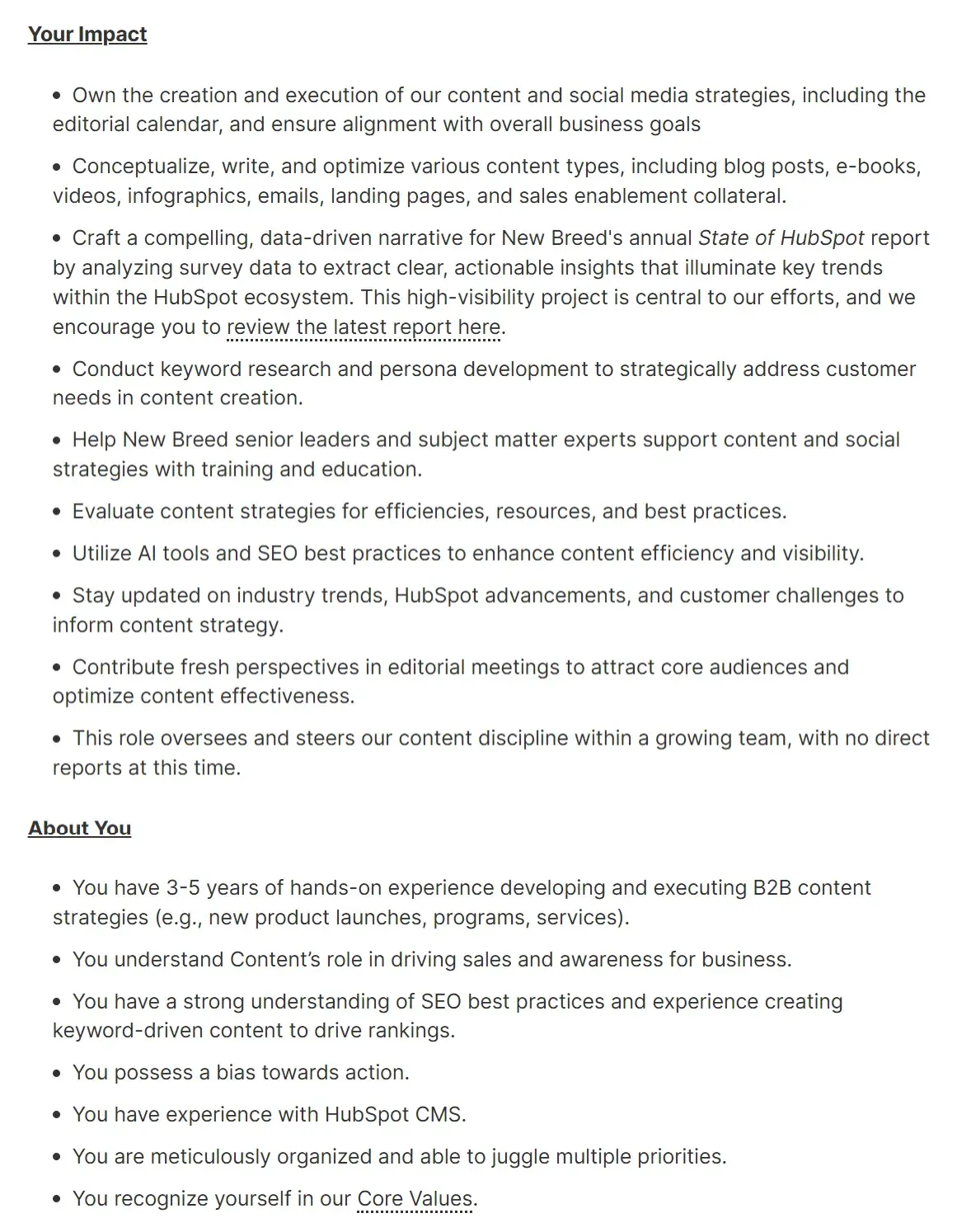
The focus on aligning content strategies with lead generation and client engagement resonates with me because it highlights the strategic importance of content in achieving broader business goals.
It reminds me that content managers today need to think beyond individual assets and consider how those pieces fit into the bigger picture.
What really stood out to me was the emphasis on metrics and analytics. In my experience, data is the difference between good content and content that performs.
The idea of not just creating content, but continuously optimizing it based on performance data, feels like the heart of this role. It’s not just about producing; it’s about learning, iterating, and improving with every campaign.
If I were to step into this position, I’d see it as a chance to stretch my creative and analytical muscles.
This role perfectly illustrates the modern content manager’s challenge: balancing storytelling with measurable impact. It’s the kind of role that asks you to be a strategist, a creator, and a data-driven thinker all at once.
Content Manager, Growth: Front Row
This role at Front Row immediately grabbed my attention because it’s so much more than just managing content — it’s about tying content creation directly to business growth.
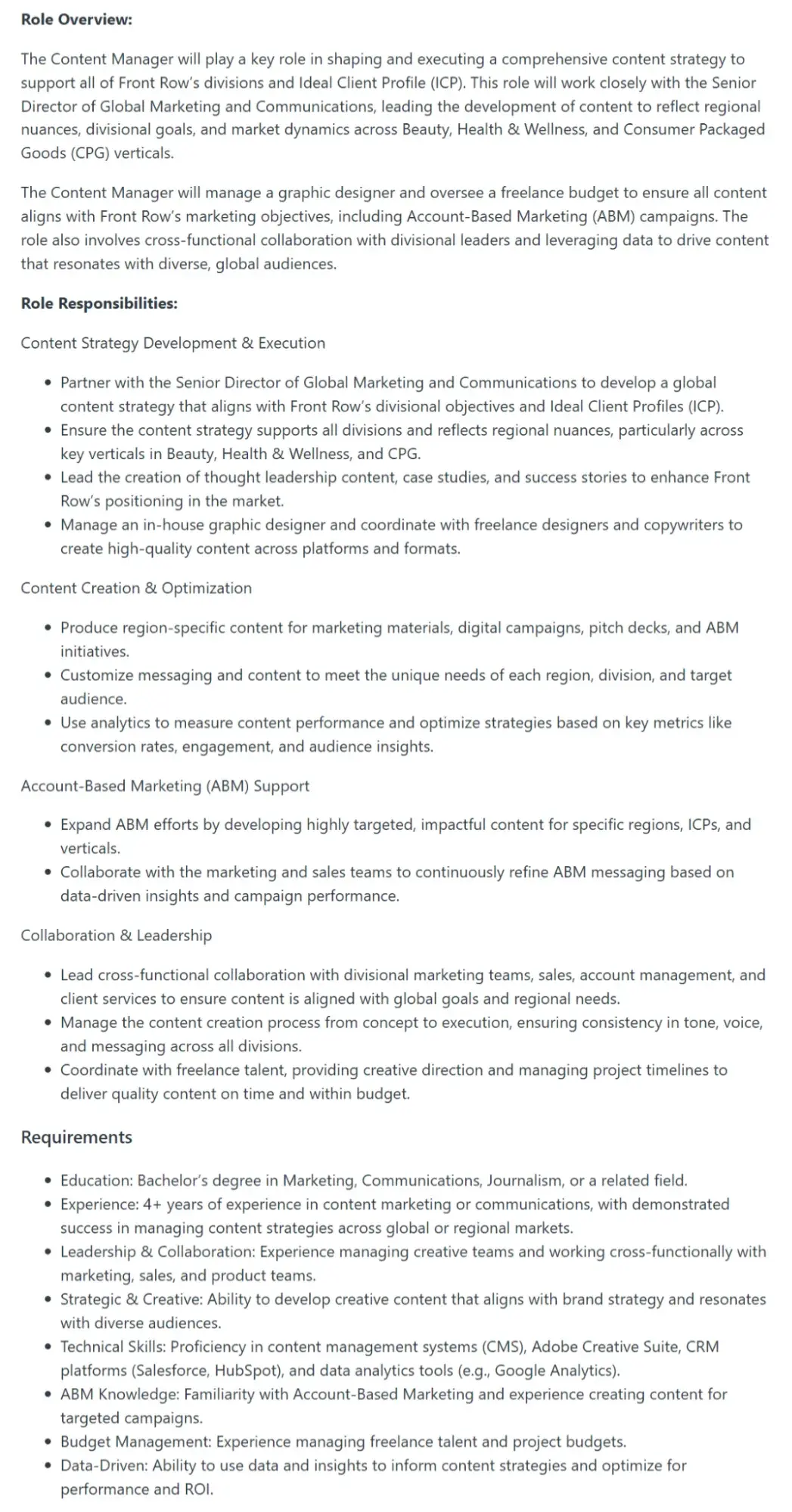
From managing a graphic designer to overseeing a freelance budget, this role demands not only creative skills but also leadership and project management expertise. For me, that blend of creativity and strategy is what makes this position truly exciting.
What really stands out is the focus on account-based marketing and demand generation. In my experience, this means you’re not just creating content for the sake of engagement — you’re creating content that supports the sales funnel and drives real, measurable results.
I’ve always believed that great content should be more than just engaging — it should influence decision-making and contribute to revenue, and this role perfectly encapsulates that.
If I were in this position, I’d see it as an incredible opportunity to stretch my strategic muscles while managing a team and collaborating with freelancers to bring bold ideas to life.
This job isn’t just about producing content — it’s about aligning content with growth, which feels like the perfect challenge for someone who loves combining creative thinking with business impact.
Content & Community Manager: 1000heads
When I look at the Content & Community Manager role at 1000heads, what stands out to me is the seamless blend of content strategy and community engagement.
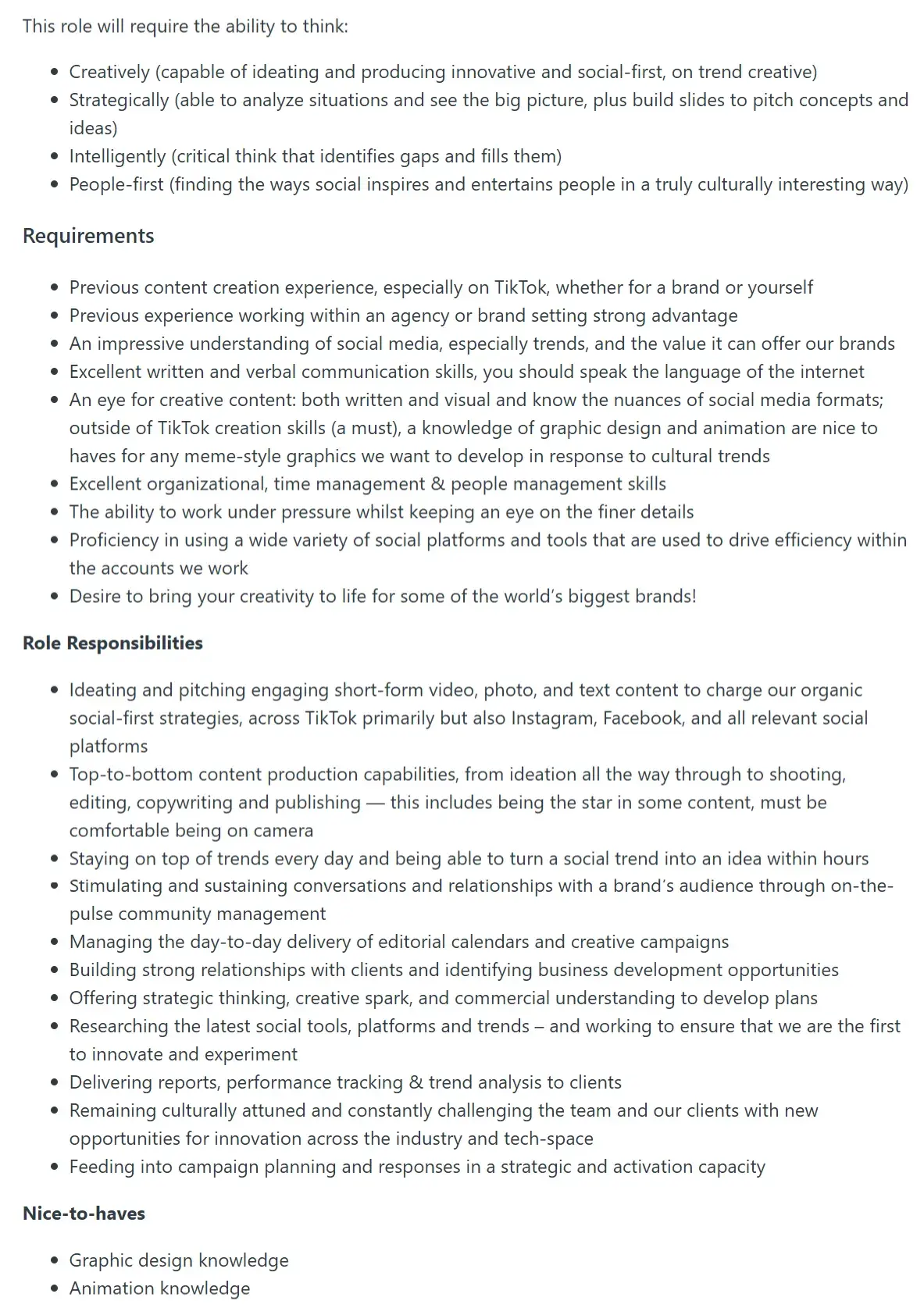
This isn’t just about creating great content — it’s about using that content to foster meaningful connections with an audience. For me, the idea of crafting strategies while actively nurturing a community feels like the perfect way to combine creativity with people-centric thinking.
What really caught my attention is the dual responsibility. On one hand, you’re creating content that aligns with the brand’s voice and goals. On the other hand, you’re building and maintaining an active, engaged community.
I’ve always believed that content should do more than just inform — it should spark conversations and build trust. This role beautifully captures that balance.
If I were in this position, I’d see it as an opportunity to not just tell the brand’s story but to live it alongside its audience. It’s a role that requires empathy, creativity, and adaptability — qualities I value in any content management position.
This feels like the kind of challenge that pushes you to think not just about what you’re creating but who you’re creating it for and how it’s making an impact.
Senior Content Marketing Manager: OrderMyGear
When I think about the Senior Content Marketing Manager role at OrderMyGear, what excites me most is the chance to build a comprehensive, multi-channel content strategy from the ground up.
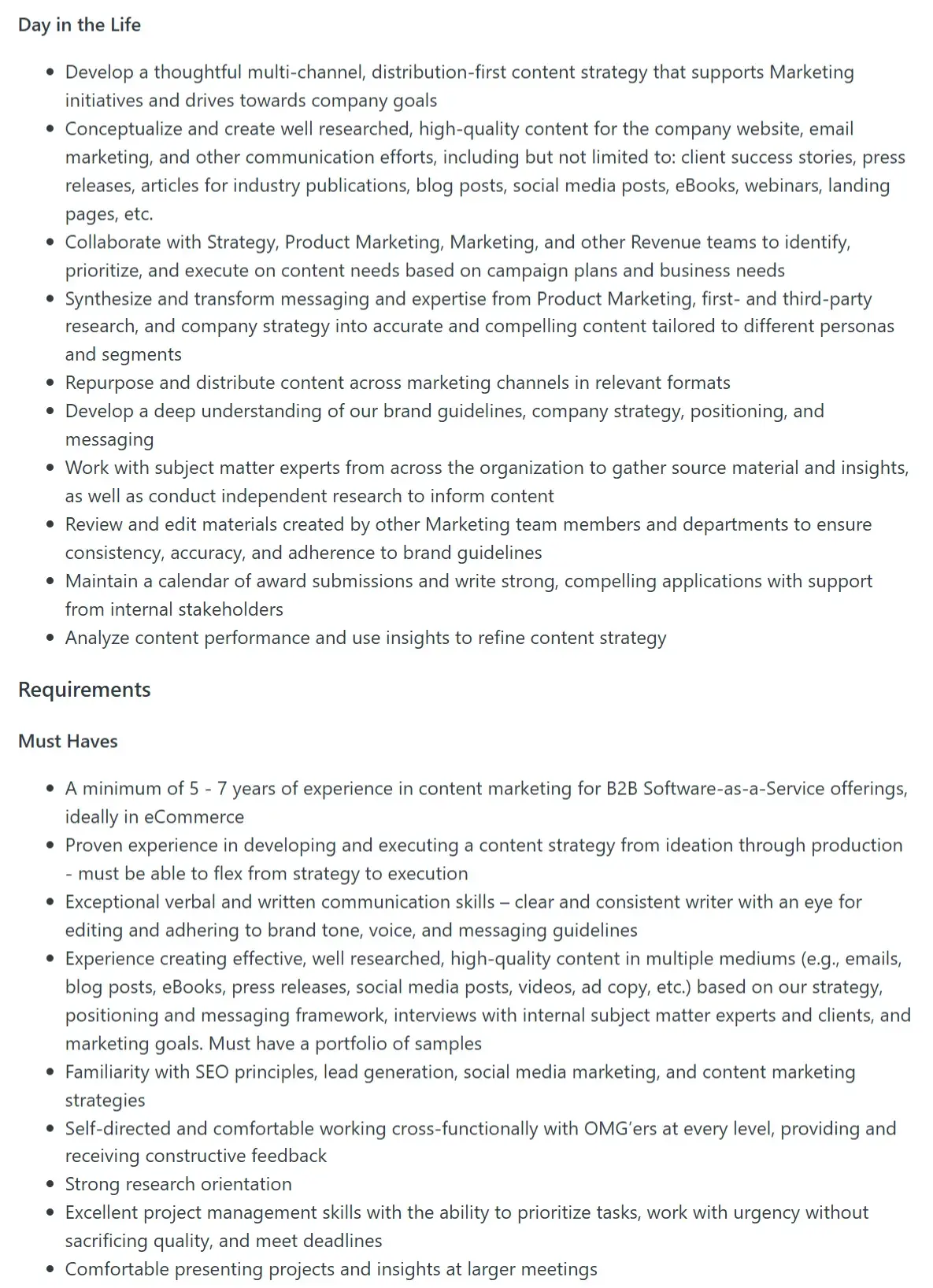
It’s not just about writing blogs or crafting emails — it’s about telling a story that positions OMG as a thought leader in the branded merchandise space. For me, that’s the kind of challenge that’s equal parts creative and strategic.
What really stands out is the emphasis on collaboration. Working closely with Strategy, Product Marketing, and Revenue teams to identify content priorities resonates with how I like to approach content — by aligning it with broader business goals.
I’ve always believed that the best content strategies are those that don’t just exist in isolation but actively contribute to growth.
Another aspect of my approach that aligns with it is the focus on repurposing and distributing content across multiple channels. In my experience, great content doesn’t stop at creation—it’s about finding ways to adapt and amplify it to reach the right audiences.
The idea of blending creativity with data-driven insights to refine strategies feels like the perfect combination for making a real impact in this role. If I were stepping into it, I’d see it as an opportunity to shape how content drives both brand perception and tangible results.
Content & SEO Manager: VisitorsCoverage Inc.
This role immediately caught my attention because of how seamlessly it blends content strategy with technical SEO.
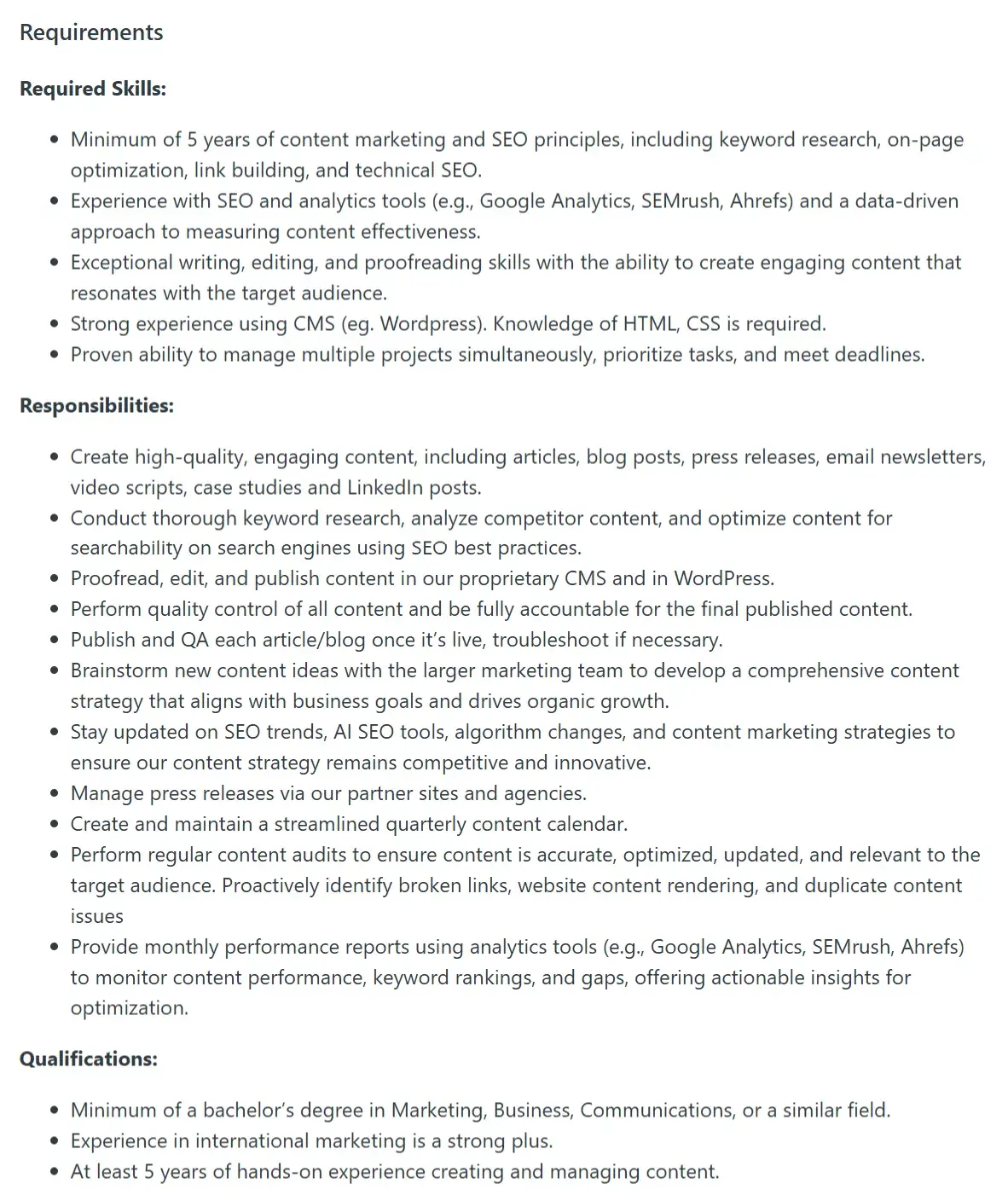
For me, this position is the perfect example of how modern content management is evolving — it’s no longer just about creating compelling stories but ensuring those stories are discoverable and impactful.
The focus on driving organic traffic and improving search rankings feels like a challenge that requires both creativity and technical expertise.
What stands out most is the emphasis on data-driven decision-making. I’ve always believed that data is the key to turning good content into great content.
The idea of using analytics to monitor user behavior, measure content effectiveness, and refine strategies resonates deeply with how I approach content creation. It’s not just about publishing — it’s about constantly iterating to achieve measurable outcomes.
If I were stepping into this role, I’d see it as an opportunity to combine my storytelling and SEO skills to create a lasting impact.
It’s about more than just writing — it’s about crafting a digital presence that delivers value to both the audience and the business. This role feels like the perfect balance of strategy, creativity, and technical execution.
From Content Creation to Strategic Leadership: Your Next Career Move
When I first started exploring content management, I wondered if it was just an elevated writing role.
Now, I see it as a dynamic intersection of strategy, creativity, and leadership. Whether you’re a writer looking to expand your impact or someone drawn to the evolving world of digital content, the path to content management offers rich opportunities for growth.
The key is to start where you are. Use your existing skills, build the ones you need, and remember that every content manager’s journey is unique.
As you’ve seen from the job descriptions shared here, companies need content managers who can think strategically, adapt quickly, and lead with purpose.
Ready to take your first step? Start by strengthening one skill that caught your attention in this guide. The content landscape is always evolving, and that’s exactly what makes this role so exciting.
Editor’s note: This post was originally published in April 2020 and has been updated for comprehensiveness.


